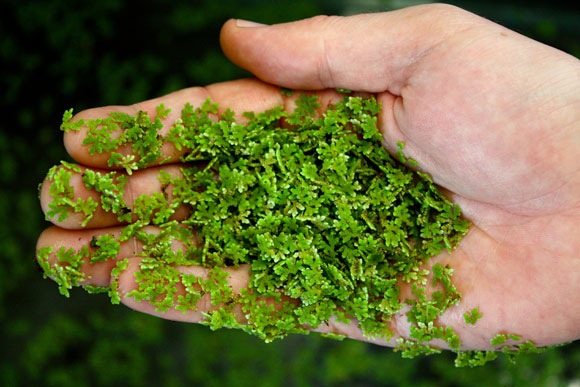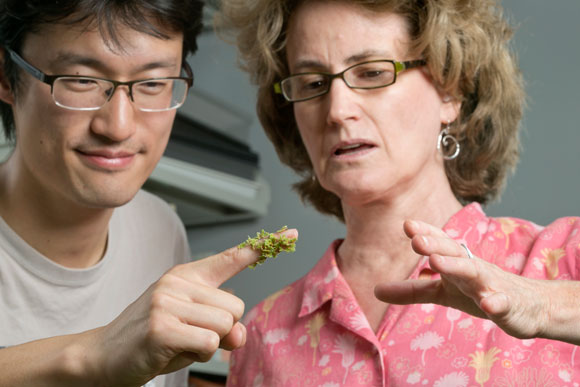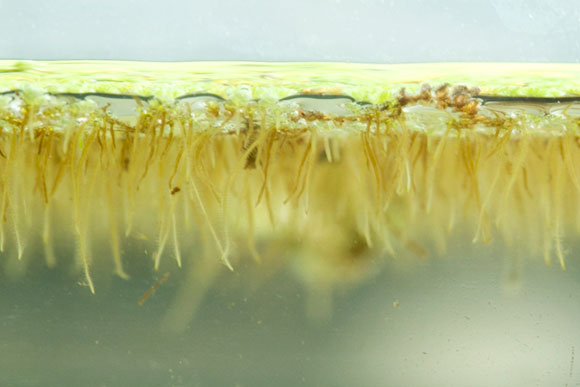
Oh, the people you will meet when raising money for science. Biology professor Kathleen Pryer knows this now, after first writing an op-ed and then joining grad student Fay-Wei Li in launching a crowdfunding project on behalf of the tiny aquatic azolla, sidelined as a "lowly fern" in plant genome studies.
"This has been so much fun," she says. "I haven't felt so popular since ... well, never."
Pryer is leading a group of researchers at Duke and Utah State University who are raising money through Experiment.com to sequence the azolla genome. As Pryer told Phys.org, "azolla and (its microbes) can combat global warming and produce precious nitrogen to help feed the world."
Pryer's bid to use the fern for carbon-capture are gaining attention in places scholarship usually doesn't appear. A science fiction writer got the ending for her novel from Pryer's op-ed, which appeared in newspapers from Toronto to Cleveland to San Francisco. A Canadian psychiatrist was so moved by Pryer's proposal that he wants to help raise the needed funds for the sequencing -- the first ever for a fern.
But the connection Pryer most treasures is with a recent high school grad -- soon to be a student at the University of Oklahoma -- who calls her his "new science hero." He's been sending tweets and "thinks the project is great."
"It's neat," she says, "to reach out beyond the bubble to people who really are concerned with the fate of the planet."
Using crowdfunding to raise money for science neglected by conventional grant-giving agencies has only recently become feasible. Pryer says she became aware of Experiment.com through a grad student in California who received $7,000 for an Alpine plant diversity study in the Arctic.
Her repeated appeals to granting agencies for funding to unlock the know-how embodied by the azolla superorganism have been met with responses like "too unconventional" or "too risky." She decided "if the traditional sources aren't interested, we'll see if the general public is."
What got the ball rolling was a chance encounter Pryer had in April with David Jarmul, associate vice president of news and communications, soon after Li's research on how ferns borrowed genes to thrive in low light was featured in The New York Times, The Economist and elsewhere. Jarmul asked what else was going on and she blurted out her frustration with not being able to interest traditional funders with azolla. He encouraged her to write the op-ed.
"It's been an eye-opener," Pryer says. "People really do read op-eds."
In the commentary, Pryer explained how azolla, by hosting a microbe called nostoc, captures all the nitrogen fertilizer it needs from the atmosphere around it, and then some. "Since the dawn of agriculture," she wrote, "Asia's farmers have known about, and deliberately exploited, the benefits of growing azolla as a companion plant with rice. The floating fern thrives in rice paddies, fixing nitrogen and other nutrients, constantly improving the soil composition and providing a natural, green fertilizer that significantly bolsters rice productivity.

Fay-Wei Li, Kathleen Pryer and their favorite fern, azolla. Photo by Les Todd/Duke University Photo
Pryer and Li launched the crowdfunding effort in late May. That led to Pryer's appearance in early June on reddit's "Ask Me Anything" chatroom, and that, in turn, has led to contacts with journalists for Inside Higher Ed, The Guardian and The Economist. Visits to her webpage spiked with the reddit exposure and she hopes there will be more reaction -- and a bump in giving -- as people read her blog post on GigaScience.
The project has 22 days remaining to meet a funding target of $15,000. So far, it has raised $4,209 with the help of 60 backers. As with public TV festivals, major contributors get special treats. Give $500 and you receive a USB drive containing the azolla genome sequences as soon as the data are ready to be released.
If fully funded, the researchers will draft the first ever sequence of a fern genome. This will provide not only a framework to examine evolutionary patterns in land plants, but also a critical resource for nitrogen fixation, biofuel production and symbiosis research.
When backers give money to the project, they receive behind-the-scenes access to research updates, and recognition in the published results. "Our citizen science approach has allowed us to reach out and directly engage with the general public," Pryer says.
Pryer said that as expected her team spends a couple of hours a day, answering public emails and tweets. Li assists in responding to the inquiries, which she says "peak and fall."
She's encouraged that the general public is taking an interest in science that has a big green potential. "We owe it to the public, after the taxes they pay for research, to explain what it is we do." And this approach "feels a lot more energizing" than the usual "tried and true approach" of grant-writing for foundations. "You feel that everyone is on board cheering for you."
In a response to one questioner on reddit, Pryer said that communicating what she and her team do "has become increasingly important to me the older I get." That was certainly the motivation in 2012 for naming a new genus of ferns for pop music star Lady Gaga. "We could have called it 'Mexipteris' and no one would have cared," she wrote. "By making a connection with pop culture (based on several fern features) we were able to make a connection with what we do and the public who have no idea what we do."
Below: A colony of azolla ferns with their root system. Photo by Les Todd
